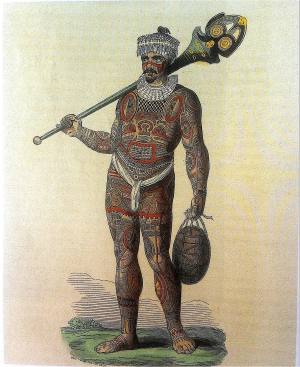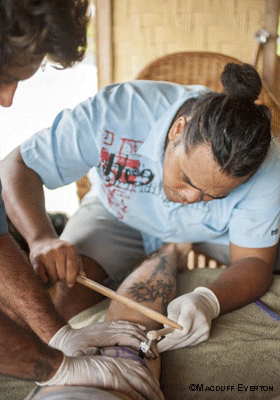
POLYNESIAN TATTOO
The origin of the English word ‘tattoo’ actually comes from the Tahitian word ‘tatau’ and goes back as far as 1500 BC. In ancient Polynesian society, nearly everyone was tattooed. It was an integral part of ancient Tahitian culture and was much more than a body ornament. Tattooing indicated ones genealogy and/or rank in society. It was a sign of wealth, of strength and of the ability to endure pain. As such, chiefs and warriors generally had the most elaborate tattoos. Tattooing was generally begun at adolescence, and would often not be completed for a number of years. Tattooing was not limited to men. Tahitian women were also tattooed – it was an indication of a girl’s sexual maturity.
With the arrival of Europeans, came a dramatic change to both tattooing and the culture in general. Captain Cook and others returned from the Pacific with tales of exotic islands, of “savage” cultures indulging in erotic dance and bizarre rituals. One of these rituals was tattooing. It wasn’t until the arrival of the missionaries that this art form was nearly killed. Considered to be a sinful glorification of the skin, the missionaries strictly forbid tattoo. Fortunately the art of tattooing was well documented and it is only in recent years (since 1981) that tattooing has enjoyed a renaissance. Today, Tahitian tattoo has again gained recognition as a highly respected art form and is sought by travelers the world over.
Traditional Tahitian Tattoo
Traditional Tahitian tattoo is the tattoo practice originally invented by my ancestors. The word tattoo comes from the Tahitian word tautau. Tautau was the sound made by tattooing — tat tat. Traditional tattoo involves the creation of traditional tattooing tools called tatatau. The tools consist of a comb with anywhere from 3-20 needles and are carved from bone, shell or shark’s teeth. These “needles” are placed on the skin and the handle is tapped with a second wooden stick, causing the skin to puncture thus inserting the pigment.
The tools are made specifically for you, used only on you. It takes two artists to do a traditional tattoo — one to stretch the skin and the other to do the tat-tau-ing. Traditional tattooing was banned in 1986 by the Tahiti-based French Ministry of Health due to the difficulty in sterilizing the wooden and bone equipment but was allowed again in 2001. There are only a handful of artists left in Tahiti who still practice this art form. I happen to be one of them.
Polynesian Tattoos – Heavy in Symbolism
All symbols in Tahitian tattoos are based on the 4 elements (Ocean, Earth, Wind, Fire). For each symbol there is a sacred ceremony. There are different symbols related to those elements. In ancient Tahitian society, tattoos represented one’s genealogy and social rank. There were symbols specific to certain families and symbols unique to various roles. For example, the tattoos of warriors would incorporate symbols different than those of fishermen. Today, Tahitian tattoos signify ones ancestors and interests. Each symbol takes on personal meaning. There are symbols that represent the sea and symbols of the land, stability, travel etc. A few commonly incorporated symbols include:
» Turtle = Fertility
» Dolphin = Wisdom
» Tiki = Protection



